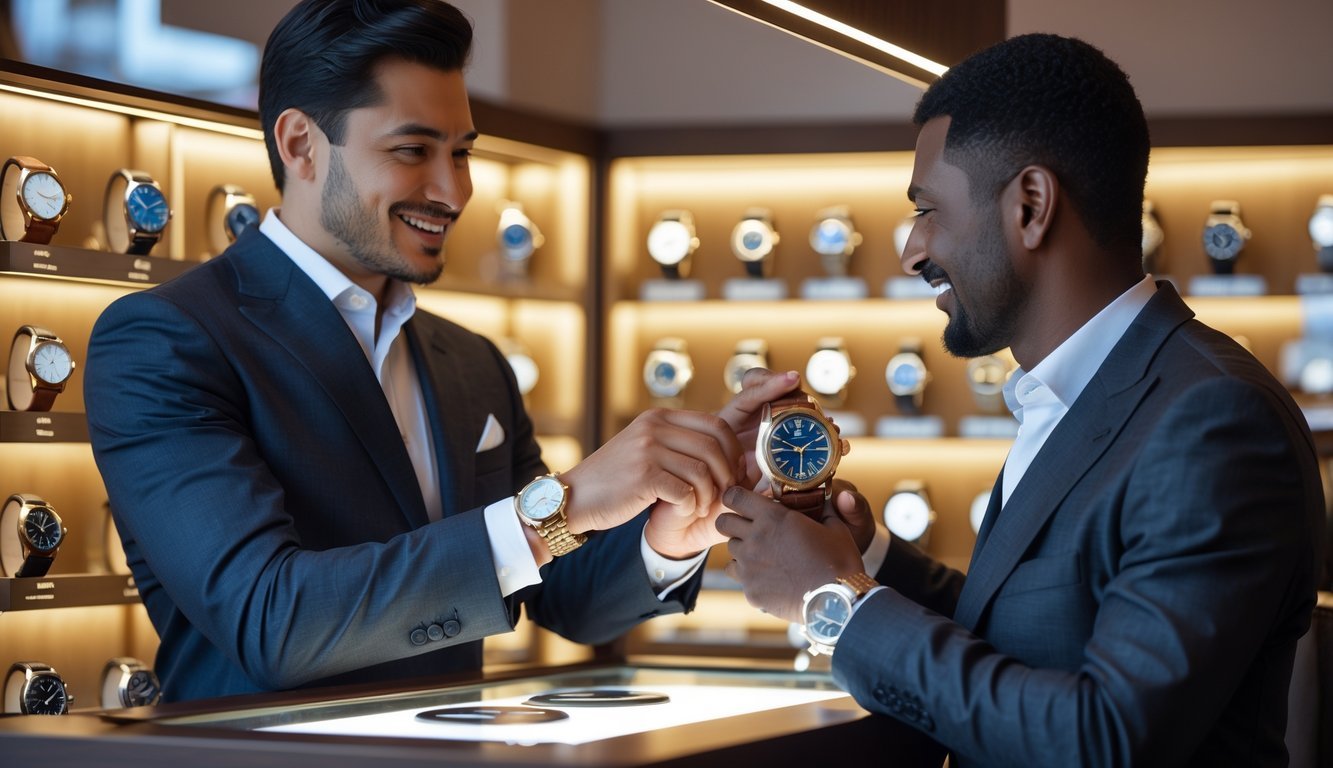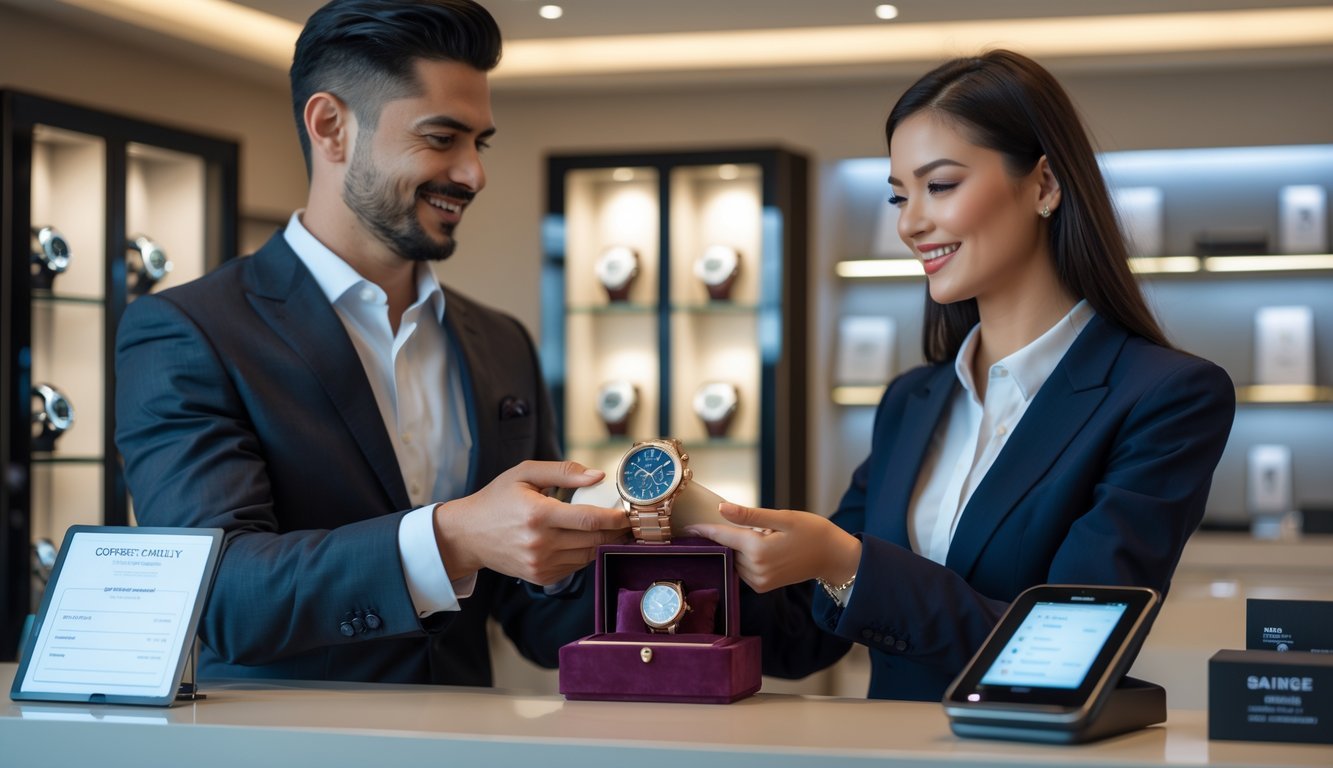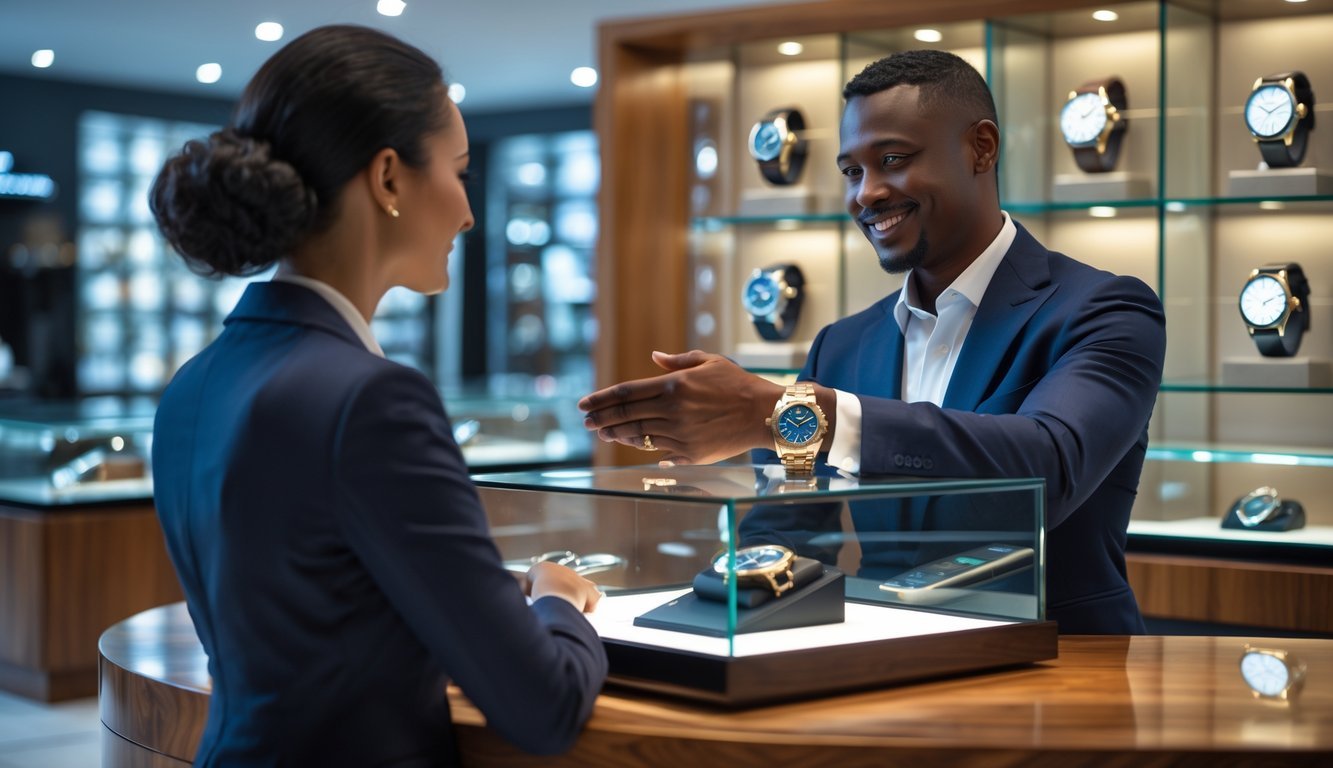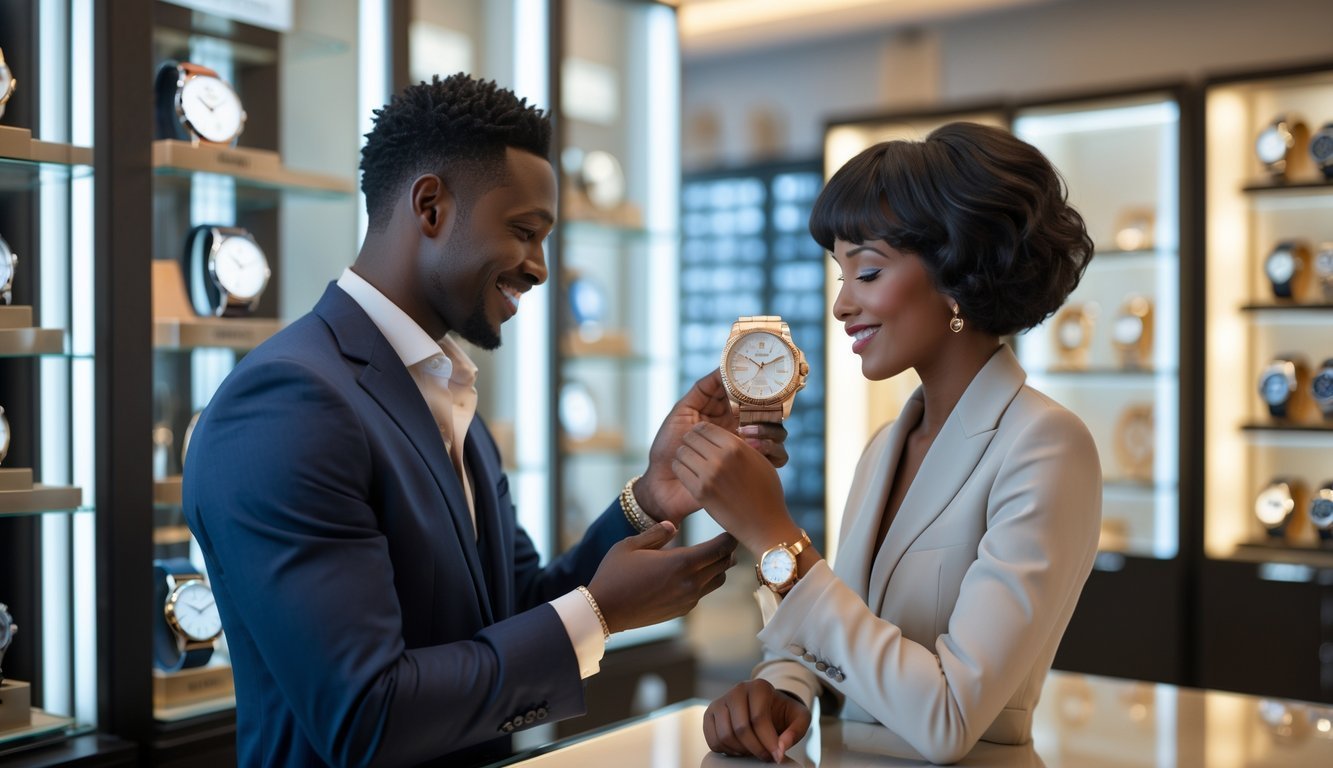Selling a luxury watch takes more than snapping a few photos and waiting for offers.
When you’re dealing with expensive timepieces, buyers want serious reassurance about authenticity, condition, and whether the transaction will be safe.
If you want to sell a luxury watch, you’ve got to be upfront about its history, condition, and authenticity.
Proper paperwork and secure payments matter. Buyers are spending a lot, so they expect all the details and proof to feel good about their investment.
It takes effort to build trust with buyers.
Show them authenticity certificates, lots of clear photos, and keep communication open about every part of the watch you’re selling.
Key Takeaways
- Give buyers full documentation and clear photos to prove the watch is genuine and in the condition you say it is.
- Use safe payment methods and reliable platforms to protect both sides during the sale.
- Keep your communication honest and open from start to finish so buyers feel confident.
Building Buyer Confidence with Authenticity and Transparency

Buyers want to see proof your luxury watch is authentic and matches your description.
Honest paperwork and clear details go a long way.
Verifying Watch Authenticity
Start with original purchase receipts and warranty cards.
These show your watch came from an official dealer.
Take sharp photos of the serial number on the case.
Most brands engrave it between the lugs at 6 o’clock or 12 o’clock.
Get a professional authentication certificate from a certified watchmaker.
For watches over $5,000, buyers often expect this.
What buyers want to see:
- Original purchase receipt
- Warranty card with matching serial number
- Authentication certificate from a certified dealer
- Service records from authorized repair centers
Check the watch’s details against the manufacturer’s specs.
Look at the movement, dial, and case materials to make sure everything matches.
Presenting Clear Documentation
Keep all paperwork organized in a folder or binder.
Include receipts, warranty cards, service records, and authentication certificates.
Scan everything at high quality and make digital copies.
Send these to serious buyers before meeting up.
Must-have documents:
- Original box and papers
- Purchase receipt with date and dealer name
- Warranty card with serial number
- Service history from authorized centers
- Authentication certificates
Hold onto the original documents during viewings.
Show buyers the originals, but only hand over copies until you’ve received payment.
Make a quick fact sheet with the model number, year, service history, and any changes you’ve made.
Honest Condition Descriptions
Tell the truth about every flaw in your listing.
Don’t hide scratches, dents, or replaced parts—it just causes problems later.
Use clear terms buyers understand.
For example, say “light scratches on bracelet” instead of something vague like “minor wear.”
Condition scale:
- Mint: Perfect, never worn
- Excellent: Barely any wear
- Very Good: Light scratches, normal use
- Good: Noticeable wear, maybe some dents
- Fair: Heavy wear, probably needs service
Take photos in natural light, showing every angle.
Get close-ups of any damage or worn spots.
If you replaced any parts, say so.
Mention things like new crystals, crowns, or bracelet links right in your description.
Establishing Trust and Handling Transactions Securely

Trust is everything when selling luxury watches.
Buyers are spending thousands, so you need to protect them (and yourself) with secure payments, solid references, and clear return policies.
Offering Secure Payment Options
Let buyers pay the way they prefer.
Bank wires are usually the safest for big purchases—most buyers choose this for anything over $5,000.
Credit cards through trusted services like PayPal or Stripe are also popular.
They charge fees, but buyers get protection if something goes wrong.
Skip personal checks or money orders for pricey watches.
Good payment options:
- Bank wire transfers (most secure)
- PayPal Goods & Services
- Escrow services for expensive sales
- Credit cards via reputable processors
Be careful with cryptocurrency.
It’s risky and offers no real protection.
If you’re meeting in person for cash, do it somewhere safe.
For watches over $10,000, think about using escrow services.
They hold the money until both sides are happy.
It’s not free, but it helps everyone feel safer.
Showing Reputable References
Show off positive feedback from past buyers.
Add recent testimonials with real details about your service.
Screenshots of good reviews from watch forums help a lot.
Share your credentials and any watch industry certifications.
If you’ve been trained or are part of a professional group like the American Watchmakers-Clockmakers Institute, mention it.
Ways to show you’re trustworthy:
- Customer testimonials with photos
- Reputation scores on watch forums
- Professional certifications
- Years in the business
- High-value deals you’ve completed
If someone asks, offer references from recent high-value sales.
Give contact info for past customers who said it’s okay.
This is especially helpful for rare or vintage pieces.
Join well-known watch trading sites with verified seller programs.
Places like Chrono24 and WatchStation check seller identities.
They charge fees, but buyers feel safer.
Providing Transparent Return Policies
Give buyers a clear return window.
Seven to fourteen days is pretty standard, so they can check out the watch.
Spell out your return policy in writing before the sale.
Tell buyers what shape the watch needs to be in if they want to return it.
Make sure they send back the box, papers, and extras.
Return policy basics:
- Time: 7-14 days from delivery
- Condition: Unworn, original packaging
- Refund: Same method as payment
- Return shipping: Buyer pays
- Inspection: 48 hours after you get it back
Only charge a restocking fee if you really need to.
Five to ten percent is typical, but be upfront about it.
Before you ship, document the watch’s condition.
Take lots of photos and maybe a video.
This helps if someone claims damage during shipping.
Handle returns fast and professionally.
Try to process refunds within 48 hours after you get the watch back.
Quick refunds make you look reliable for future sales.
Frequently Asked Questions

Buyers usually have questions about authentication, warranty coverage, and transaction security when they’re looking at luxury watches.
Here are some common concerns.
What authentication process can I expect when purchasing a luxury watch?
A pro will check the serial and reference numbers first.
They’ll compare these to the brand’s records to make sure the watch is real.
Watchmakers also inspect the movement, case, and finishing.
They look for anything that seems off or parts that don’t match the original.
They use special tools to test performance and accuracy—timing machines show if the watch keeps proper time.
They’ll review all the paperwork, too.
If something doesn’t add up, they’ll flag it before approving the sale.
How do warranty and after-sales services work when buying high-end watches?
Most manufacturer warranties last 2-5 years, depending on the brand.
They cover defects, but not accidents or misuse.
Some dealers offer extra warranty coverage.
These can include things like routine maintenance or parts replacement.
After-sales services might cover cleaning, regulation, or small repairs.
A lot of authorized dealers keep helping even after the warranty ends.
Service centers keep records of all work done.
This helps keep up the watch’s value and gives you a full service history.
Can you provide details on the history and condition of pre-owned luxury watches?
Service records show when the watch was last serviced and what was done.
This lets buyers know how well the watch was cared for.
Condition reports list any scratches, dents, or signs of wear.
Grading systems rate the overall condition from excellent to poor.
You can usually find out how many owners the watch had.
Sometimes dealers know how the watch was used or stored.
If there are any replacement parts, they’ll be listed.
The report will say what’s original and what’s been swapped or serviced.
What are the payment options and financial protections for buyers of luxury timepieces?
Escrow services hold your payment until you get and approve the watch.
This helps protect both sides.
Credit card payments let you do a chargeback if there’s a problem.
Many dealers take cards, even with the extra fees, because buyers feel safer.
Bank wire transfers are common for bigger purchases.
Some dealers might offer payment plans or financing if you qualify.
Insurance covers your watch during shipping and right after you buy it.
Some dealers include short-term insurance until you can add the watch to your own policy.
How can I be sure of the watch’s provenance and authenticity?
A certificate of authenticity proves the watch is genuine.
It lists specs, serial numbers, and has signatures from experts.
Provenance records show the watch’s ownership history—things like original receipts, service records, and past sales.
Some third-party services offer independent verification.
Groups like the American Society of Appraisers can do this.
You can also get official manufacturer verification.
Some brands will authenticate their watches no matter where you bought them.
What measures are taken to ensure the privacy and security of the transaction?
We protect your personal information using secure databases and encryption.
We keep your contact details and purchase history private, never sharing them with third parties.
Our payment system runs on encrypted connections and uses fraud protection.
Certified secure systems handle your payment info, meeting all the usual industry standards.
We use discreet packaging and shipping, so your privacy stays intact during delivery.
If you order a high-value watch, it’ll arrive in plain packaging with no logos or obvious markings.
We store transaction records securely and limit who can see them.
Only a few authorized team members can access your purchase details or personal info.


